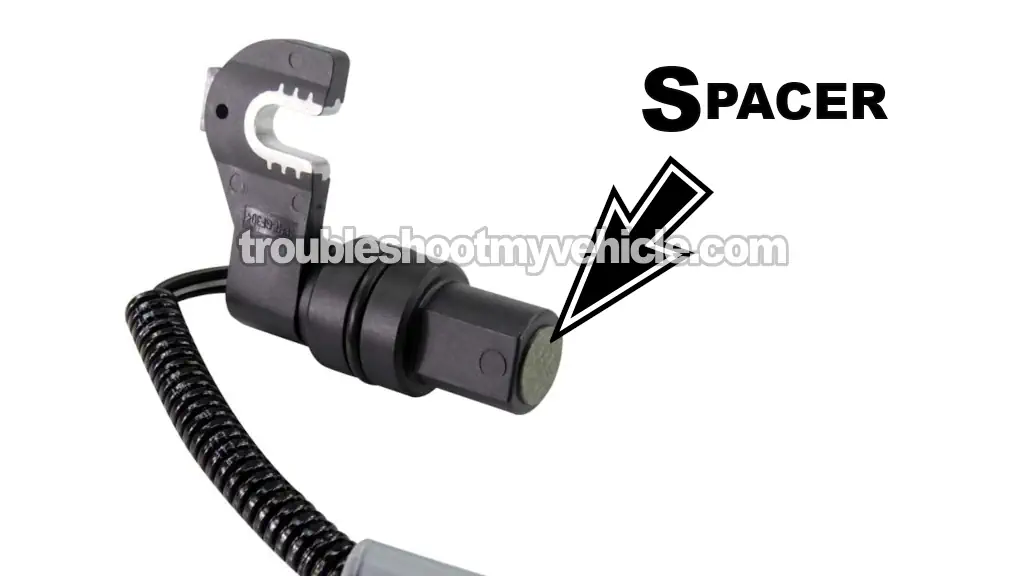TEST 2: Making Sure The CMP Sensor Is Getting 8 Volts

The camshaft position sensor needs power to generate its signal —and that power comes directly from the PCM.
Terminal #1 on the connector, which connects to the orange (ORG) wire, is the CMP sensor's power feed.
To check for the presence of power —which should be 8 Volts DC— we'll use a multimeter to confirm that the correct voltage is being delivered by the terminal.
OK, this is where the magic happens:
- 1
Disconnect the CMP sensor from its 3-wire harness connector.
- 2
Connect the black multimeter lead on the battery's negative (-) terminal.
- 3
Switch your meter to read DC Volts.
- 4
Carefully probe the terminal marked 1 on the connector with the red multimeter test lead.
- 5
Ask a helper to turn the ignition key to the ON position, but don't start the engine.
- 6
The expected output is around 7 to 8 Volts DC.
Let's interpret your test result:
CASE 1: Sensor power present (7–8 Volts). Excellent —you've confirmed that the sensor is receiving power.
Let's move on to TEST 3 to make sure the Ground circuit is good: TEST 3: Making Sure The CMP Sensor Is Getting Ground.
CASE 2: No 7 to 8 Volts at terminal #1. Make sure your meter is connected properly and try again.
Still no voltage? That means the sensor isn't the culprit —you're dealing with a wiring issue, likely an open-circuit problem in the ORG wire from the PCM.
Your next step is to find out why this voltage is missing and restore them to the ORG wire to resolve the CMP sensor problem.
TEST 3: Making Sure The CMP Sensor Is Getting Ground

So far, you've verified two key things:
- The CMP sensor is getting power (TEST 2),
- But it's not producing its ON/OFF signal (TEST 1).
Now we need to check if it's receiving the Ground it needs to function.
This Ground is supplied by the PCM through the black with light blue stripe (BLK/LT BLU) wire on the CMP sensor's 3-wire connector.
The BLK/LT BLU wire connects to terminal #2, as shown in the connector pinout diagram above.
WARNING: Never jumper this wire to 12 Volts —doing so can permanently damage the fuel injection computer. We'll safely check for Ground using a multimeter and a simple voltage test method.
Let's get going:
- 1
Disconnect the CMP sensor.
- 2
Connect the red multimeter test lead to the battery's positive (+) terminal.
- 3
Put your multimeter in DC Volts mode.
- 4
Use the black test lead to probe terminal #2.
Confirm that terminal 2 connects to the BLK/LT BLU wire. - 5
Turn the ignition ON but don't crank the engine.
- 6
You should see 10 to 12 Volts DC on your multimeter.
Based on your test result, here's what's going on:
CASE 1: You see 10 to 12 Volts DC on the multimeter. Great —that confirms the CMP sensor has a proper Ground path.
If you've already confirmed it gets power (TEST 2) but doesn't generate an ON/OFF signal (TEST 1), then the CMP sensor has failed and should be replaced.
NOTE: If you're installing a new sensor, see: Installing The CMP Sensor: Air Gap Clearance.
CASE 2: Meter stays at 0 Volts (or close to it). Recheck all test leads and connections.
If the reading is still low, then the Ground circuit —specifically the BLK/LT BLU wire —is open somewhere between the connector and the PCM.
The sensor won't function without this Ground signal, and the wire will need to be traced and repaired.
Installing The CMP Sensor: Air Gap Clearance

The CMP sensor in your 1994–1997 3.3L Dodge Caravan relies on a precise air gap between its tip and the camshaft gear to function correctly —and to avoid being damaged by the gear when cranking the engine.
This gap is maintained by a paper spacer, approximately 0.020 inches (0.5 mm) thick, affixed to the sensor's tip during installation.
When you buy a new CMP sensor, it comes with this spacer already installed —and it's crucial not to remove it. It ensures the correct clearance once the sensor is secured to the timing cover with its bolt.
If you're reinstalling an old sensor or the original spacer is missing (which it almost always is), you can either buy a replacement online (or make your own):
- Buy it here: Walker Products 235-1378 CMP Sensor Spacer (at: amazon.com).
What I've done in the past is cut small circles from index cards, stack and glue them together until they reach the required thickness. This DIY spacer works just as well as the factory one.
Remember, the key is to maintain that necessary air gap so the sensor doesn't get destroyed the moment you crank the engine.
More 3.3L V6 Chrysler, Dodge, And Plymouth Minivan Tutorials
You can find a complete list of 3.3L V6 Chrysler, Dodge, and Plymouth minivan tutorials in this index:
Here's a small sample of the tutorials you'll find in the index:
- P0171 Diagnostics (1996-2010 3.3L V6 Chrysler, Dodge, And Plymouth Minivan).
- P0420 Diagnostics -Catalytic Converter Tests (1996-2010 3.3L V6 Chrysler, Dodge And Plymouth Minivan).
- How To Check For Vacuum Leaks: Carb Cleaner Spray (1991-2010 3.9L V6 Chrysler, Dodge, And Plymouth Minivan).
- How To Test For A Blown Head Gasket (1991-2010 3.3L V6 Chrysler, Dodge, And Plymouth Minivan).

If this info saved the day, buy me a beer!

